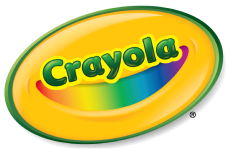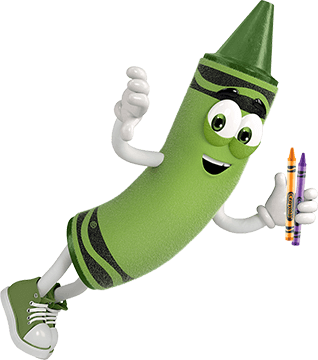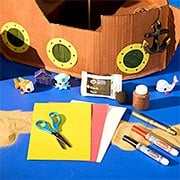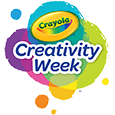En 1958 se introdujo la caja de 64 lápices de colores CRAYOLA. Fue el primer paquete en incluir un diseño de afilador incorporado. Continuamos fabricando este diseño de paquete hoy en día en el paquete Crayola Crayon de 64 y 96 unidades.
Si tienes preguntas adicionales, ¡nos encantaría saber de ti! No dudes en llamarnos o enviarnos un mensaje de texto al 1-800-CRAYOLA días laborables entre las 9 AM y las 4 PM hora del Este. Si prefieres enviarnos un correo electrónico, visita nuestra página de contacto.
Preguntas relacionadas
Explora respuestas a preguntas comunes, consejos útiles para eliminar manchas e ideas creativas para aprovechar al máximo nuestros materiales de arte y recursos gratuitos.
-
Crayola® did not invent the crayon. The "modern" crayon originated in Europe, initially made from a mixture of charcoal and oil, later replaced by powdered pigments. Wax was later substituted for oil, making the sticks sturdier and easier to handle.
In 1902, Crayola Crayons were invented by Binney & Smith and first offered for sale in 1903. The trade name "Crayola" was coined by Mrs. Edwin Binney, combining "craie" (French for chalk stick) and "oleaginous" (oily).
Crayola manufactures over 3 billion crayons each year, primarily made from paraffin wax and color pigment. Learn more about Crayola's colorful history at Crayola.com.
-
Recognizing a need in schools for safe and affordable wax crayons, Binney & Smith created the first box of eight Crayola Crayons in 1903. Sold for a nickel, this box included red, orange, yellow, green, blue, violet, brown, and black.
The Crayola name was coined by Alice Binney, wife of company founder Edwin Binney and a former schoolteacher. It combines the French word for "chalk" ("craie") with "ola," meaning "oily."
Want to know more about our colorful history? Check out the details on Crayola's history page.
-
The wife of the founder of our company, Alice (Stead) Binney, coined the name CRAYOLA Crayons. The name comes from "craie", the French word for chalk, and "ola" from oleaginous. This has been our trademark name since 1903 when our company was founded and remains one of the most important pieces of our heritage. The first box of Crayola Crayons was produced in 1903 as an 8 count box. It sold for a nickel and contained the colors red, orange, yellow, green, blue, violet, brown and black.
-
Before Crayola® Crayons were introduced, we produced black marking crayons in 1900. These early crayons, made with dry carbon black and various waxes, are now known as Staonal® Marking Crayons, widely used in industrial settings.
Recognizing a need in schools for safe and affordable wax crayons, Binney & Smith created the first box of eight Crayola Crayons in 1903. Sold for a nickel, this box included red, orange, yellow, green, blue, violet, brown, and black. The Crayola name was coined by Alice Binney, wife of company founder Edwin Binney and a former schoolteacher. It combines the French word for "chalk" ("craie") with "ola," meaning "oily."
Want to know more about our colorful history? Check out the details at Crayola.com.
-
Crayola® Markers are made with six components consisting of: a color solution, a porous plastic nib, a plastic barrel, a cotton filament (ink reservoir), an end plug, and a cap. Although specific ingredient information is proprietary, most of the color solutions in Crayola Markers are made from water and dyes. Below is the process we follow to make Crayola Markers.
- Tiny beads of plastic are fed into a molding machine where they are melted and then molded into marker barrels. The liquid plastic becomes solid, white marker barrels in a matter of seconds.
- Any extra plastic from the molding process goes back into the molding machine to make new marker barrels.
- The marker barrels are screen printed with the Crayola brand name and most with the color name of the marker. The process is like screen printing t-shirts, where the ink colors pass through a pre-made screen onto the printing surface. Up to 6 distinct colors can be used to decorate the marker barrel at one time! The ink dries quickly as the marker barrel passes through a drying tunnel.
- The assembly machine lines up the marker barrels in the same direction as they move along a conveyor belt. The end plug and ink reservoir are inserted into the marker barrel, and the color solution is injected into the soft reservoir. The marker nib, or drawing tip, is added to the open end of the marker, followed by the cap. It takes a minute or two for the ink to travel up from the reservoir to color the nib, so the marker is ready to write!
- The finished markers are placed in a sorter - a machine with separate sections for the assorted colors. A chute drops one marker of each color onto a conveyor belt, creating the colorful assortment that will fill the marker box.
- A robotic arm opens the flat marker boxes and sends them down the conveyor belt. Another robotic arm pushes the markers into the boxes and closes them. After the assembled markers are packed in large cartons, they are ready to be shipped to stores.
Did you know....
Crayola makes more than 700 million markers a year!
- The first box of Crayola Markers was introduced in 1978 and included 8 bright colors.
- In 2014, Crayola introduced Ultra-Clean Washable Markers. They clean up easily from skin, clothing, and painted walls.
- Crayola Broad Line Markers are tested to write a minimum of 300 feet - almost the length of a football field!
- Crayola Fine Line and Super Tips Markers are tested to write a minimum of 600 feet.
Learn more about Crayola Markers on the Crayola Markers Page.




